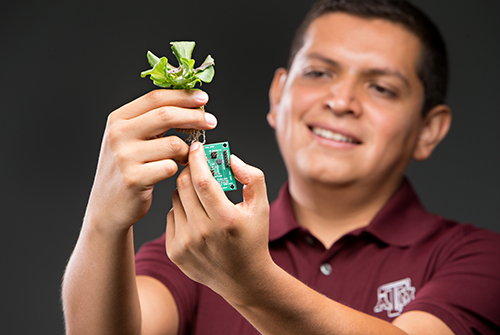 Electrifying Agriculture
Electrifying Agriculture
Alfredo Costilla-Reyes ’18 is revolutionizing indoor farming. The senior electrical and computer engineering major launched a startup company, Bit Grange, that is engineering a water-based plant system that can be sustained without soil or natural sunlight.
Growing plants using mineral nutrient solutions in water, without soil—known as hydroponics—is not a new concept, but Costilla-Reyes has designed a novel prototype that incorporates electrical components and LED lights in the plant growing process.
His technology uses sensors to collect data from plants, including variables such as light and temperature. Meanwhile, a software system evaluates these variables in real time and notifies users through BitGrange’s iPhone app to take necessary actions, such as adding more water or plant food. “This technology can not only greatly impact indoor, urban and small-scale local farming, but also has the potential to solve sustainability issues surrounding modern agricultural practices,” he said.
The prototype currently focuses on vegetable and fruit crops, but Costilla-Reyes has begun testing varieties of flowering plants as well. He also hopes that his technology, which is inexpensive and easy to use, will be used as a tool in classrooms to educate children on agriculture, engineering and science. In recognition of his achievements, he was named recipient of the Mexico National Youth Award.